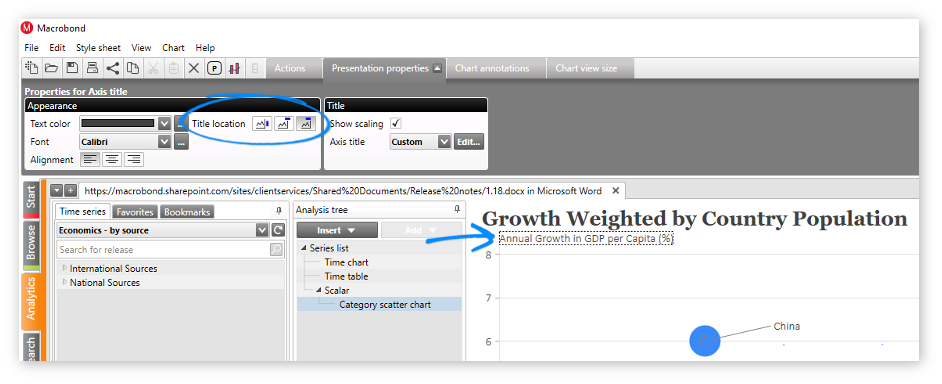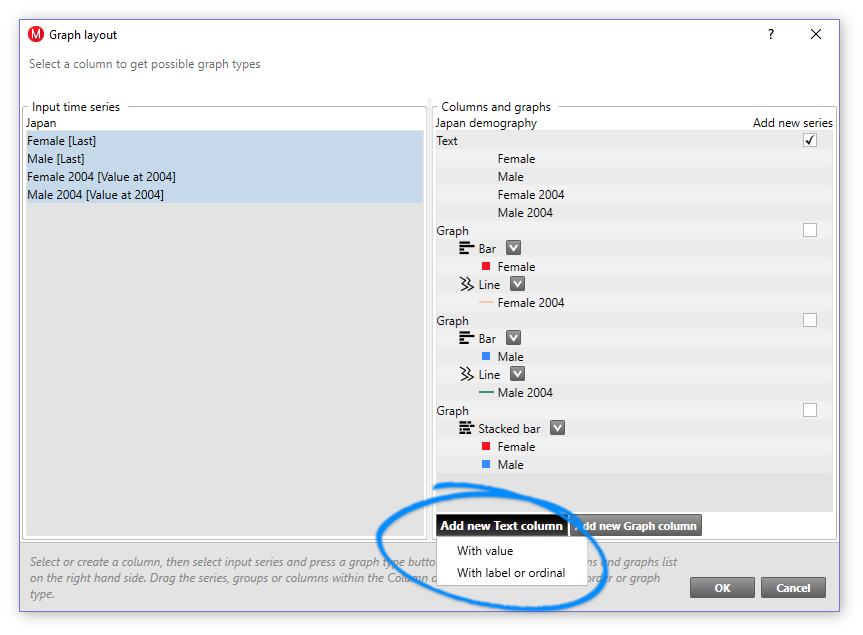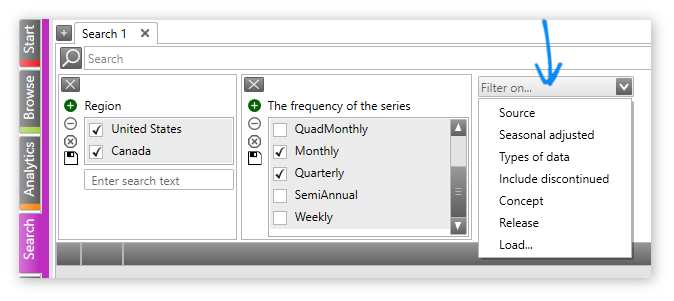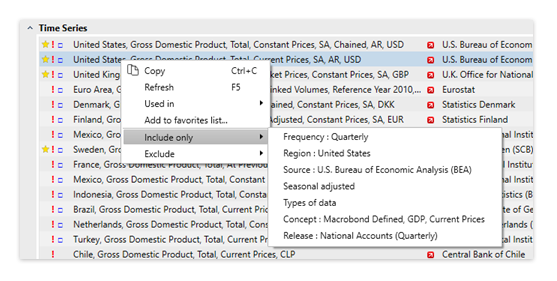Macrobond 1.18
The latest update of the Macrobond application includes changes that will substantially improve how easily you find data. We’ve also added great charting features and some new settings for analyses.
For information about installing the latest version, see the section on how to upgrade, at the end of this post.
If you would like help with installation or have any questions about how to get access, please don’t hesitate to contact the Macrobond team.
Updated logo
Due to a number of changes to our branding, you’ll notice a new logo in charts as well as brighter shades for the colors used on activity tabs and action groups.
If your stylesheet contains the Macrobond logo, any chart you create or update using this version will show the new logo.
The new logo is more discrete and will not draw attention away from your charts. Because of a slight difference in dimensions, charts created with the previous logo might look a little different when you update them.
We have also refreshed the standard style sheet that comes with the application, which you can see in the chart below.
Chart enhancements
Bubble graphs
In Macrobond 1.18, you can now visualize data using a Bubble graph.

How it works
- Like any other chart style, click on the graph layout button and click on the bubble button
- The size of the bubbles is defined by an additional variable. For scatter charts, this means that three series are used (x, y and size). For other charts, two series are used.


- Define the size of the bubbles displayed by setting the size and value.
- When the value field is empty, the size setting (pixels) will be used for the bubble with the highest value (diameter).
- When a value is entered, the number specified in size is applied to bubbles with the given value. The diameter of all other bubbles will be scaled accordingly, using linear scaling.
- By default, negative values are not included, so remember to select this setting yourself. When showing negative bubbles, the absolute value of all the values will be used as a reference for the size of each bubble.
You’ll find a step-by-step video tutorial on bubble charts here, under the heading: Using different types of charts.
Units above axis
You now have two additional options for displaying the chart axis title (unit); centered at the top, or aligned with the edge of the axis at the top.

Please note: the title text will not automatically wrap, and can overlap with the other axis title or be clipped. So, consider the length of the axis title when deciding where it should be placed.
Chart pane settings
- We have added some handy shortcuts to the graph layout dialog for setting up chart layouts with up to 3 panes.
- You can also use these buttons as a quick way to change the proportions of your chart by selecting a different pane-layout option.

Bar chart: Add value column
In Macrobond 1.18, adding text columns in bar charts has been made easier.
- When adding a text column, you can now decide if you want the column to contain series values series labels.

List of abbreviations of sources used in a document
There has always been a dynamic text that you can use in charts called DocumentSources, which generates a list of all sources used by the series in the document.
We have started adding abbreviations to most of our sources, as well as a new dynamic text property called DocumentSourceAbbreviations, which will use the abbreviations when available. If a source does not have an abbreviation, the full description will be used.
For example, if you use the text “{c DocumentSourceAbbreviations}” in a chart, you will get a list of the source abbreviations separated by comma.
Search filters
- A major update has been made to the way you use Search. You can now choose from and combine a variety of filters, such as specific countries, sources, frequencies, etc.
- Another benefit is the possibility to create, save and apply your favorite or most commonly used filters for quick access in the future. For instance, a specific list of countries that you focus on.

How it works
APPLYING FILTERS
- Apply filters and decide if you want to include or exclude the categories specified.
- Click on the plus button to include these settings in your results, or click on the minus button below, to exclude these settings.
- Some filters, like the frequency filter, show a fixed set of options. Others, like region, require you to type and search for the correct entity.
- If you want to adjust the filters and reapply them to your search results, you need to click on the search icon to the left of the search field, rather than hitting enter/return, to update the search results.
- To temporarily disable a filter, click on this symbol

- to remove the filter from your search completely, click on

- To remove all the filters, click the clear button to the right.
SAVING FILTERS
There are two options for saving filters
Filter list: A specific group of settings for a filter
Set up the settings in a filter for a particular purpose, for example a selection of countries or regions called Emerging Markets
- Click on the save icon

- for that filter
- When you create a saved filter you can choose if you want to keep it for your personal use or share it with colleagues in your department or company.
- Selecting a saved filter is the same as applying a new filter, simply select the saved filter from the short cut in the list, or click on load… to open the full directory
- Saved filters can be edited by others who have access to them. If you want to ensure that no changes are made while you are using a saved filter click the link button to break the link

Filter set: A specific combination of filters for a search
You can create and save a specific group of filters to apply to searches.
- Set up the group of filters and click on Save… to the right of the filters, or click on search in the menu bar and select save there.
- To find a saved search click on the Load… button.
- When saving or loading you can choose to set a saved search as the default. The default will be used for new search tabs or when starting the application.
RESULTS-BASED FILTERING
You can also use this new feature to filter an existing list of search results.
- Select one or more results that have properties you would like to use as a filter
- Right click on the results to open the context menu.
- Select include or exclude to adjust the filter settings based on the highlighted items in the list of results.

Series list enhancement
Several improvements to save time and productivity have been added to the Series List.
Change region by series
Change region is a feature that was introduced for documents, which made it possible to replicate an entire document and substitute the data for the same data from a different region.
- In Macrobond 1.18 you can apply this feature to specific expressions, by right clicking on the series expression in the series list and selecting change region from the list. This action will replace the series.
- Alternatively, you can also select Change region and duplicate. This will add the same series for a different region at the end of the list, as opposed to simply replacing the expression.

Series information
Under the tab, series information, you’ll find a list of all the series used in the document, with certain metadata.
An example of a use case is to make it easier to identify the series used in the document when you’ve used a lot of formulas.

- Right click on a column to customize which information is shown and in what order.
Select one or more rows and apply the change region feature from the context menu (right click). This is a convenient way to change the region for a particular subset of the series.
Refresh list of formulas
We have added a Refresh button above list of functions in the formula/function editor. The list is automatically updated, but this button can be used to force a fresh list in case some other user has made changes to the set of functions.
Analyses
VAR
Support for VECM, Vector Error Correction Modelling, has been added. This allows you to use a VAR model where variables may be cointegrated.
Rolling Regression
The Rolling Regression analysis can now produce P and T values as series:

Histogram
The Histogram report now contains median and observation count:

Scalar
- There is a new calculation called last common for scalar analyses, which will include values from the last point where all series have values.
- A new setting in scalar called “Include new series automatically” allows you turn on or off that new series are added automatically.
Presentation documents
- Charts can now be dragged between presentation documents.
- Charts from files storing calculated series can now be added to presentation documents. This allows you to easily organize and access calculated series files.
Releases
When looking at updates in the releases tab, you’ll notice that the “little blue square” is shown next to certain headline series. This icon indicates that a series has been used in a document. Right clicking on the square will allow you to see which documents the series was used in, when, and by whom. Simply click on an entry to open the document.
Excel add-in
When working with a dataset that references a Macrobond document, you can now cut & paste one or several series to change the order they are listed in.
Creating this kind of dataset is done by selecting Copy as Excel dataset in the application, or by selecting Convert to Document dataset in the Excel add-in, under All Series mode. The cut & paste feature is already available in the other types of Excel datasets.
How To Upgrade
The new version can be installed directly via the Macrobond application by clicking on the yellow ribbon, which appears on the screen, or by selecting Check for update in the Help menu. If you need assistance, a description of how to upgrade may be found here.
If you are unable to make use of automatic updates or use the setup program on https://redir.macrobond.com/go/installation, then please note that upgrades from versions prior to 1.16 cannot be done by simply installing a patch (MSP file). You need to install the base installation (MSI file) and the corresponding patch (MSP file).